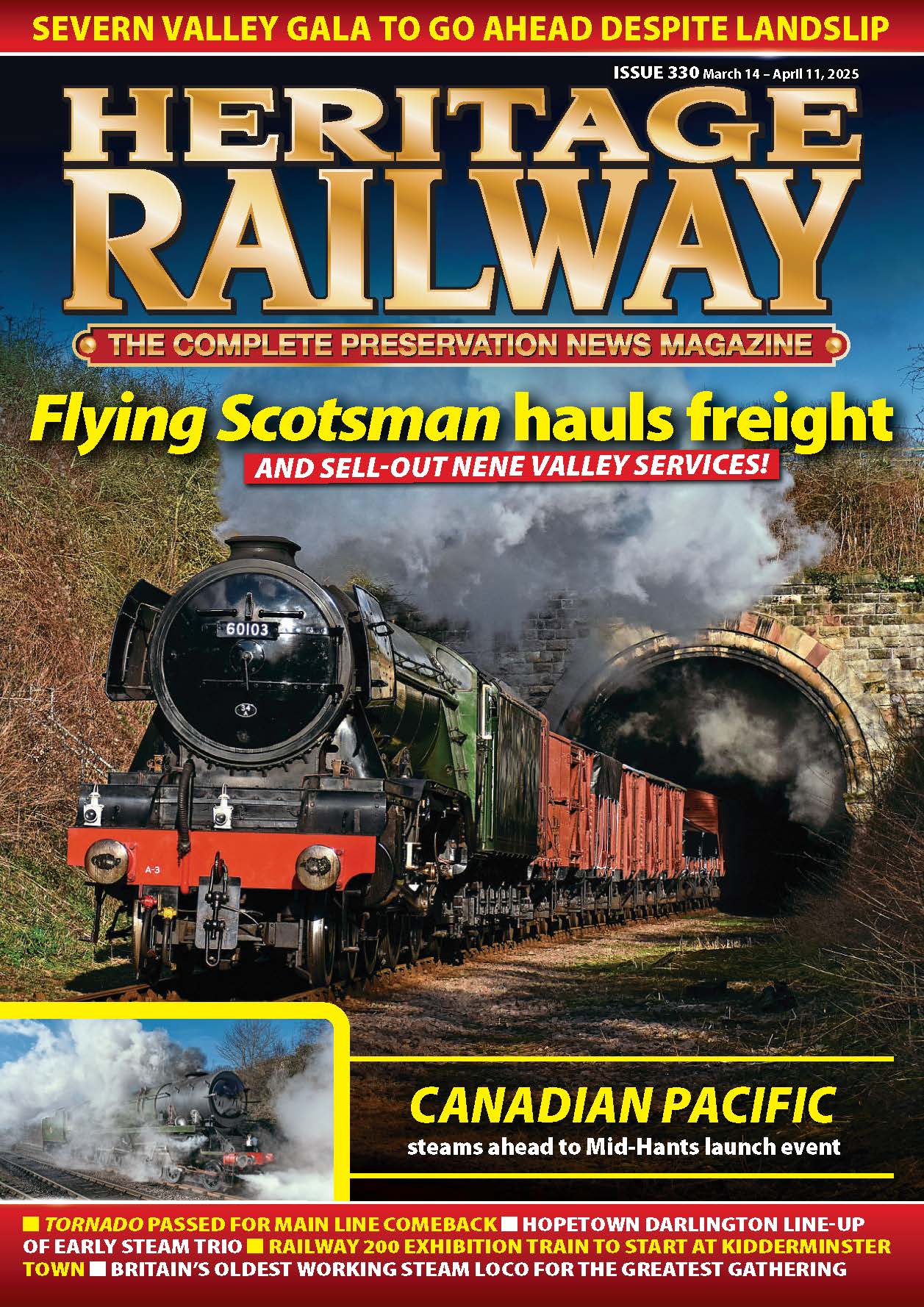One of West Coast Railways’ most respected drivers has retired. Don Benn met him and discussed Ray’s long career on the footplate.
When Ray Churchill stepped off the footplate of LMS ‘Black Five’ 4-6-0 No. 44871 at Crewe in the early afternoon of Thursday April 28 it brought to an end 59 years working on the footplates of steam locomotives, which had started at Bescot shed in 1957.
Although Ray is better known for his recent work driving steam-hauled trips for the West Coast Railway Company (WCR), his career covered much more than that and spanned the years from when the railway was almost fully steam worked through dieselisation and into the era of Privatisation.
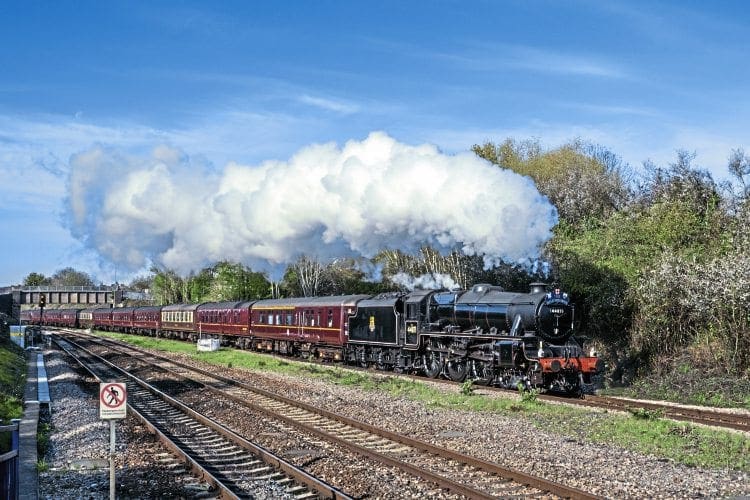
When I went to see Ray at his home near the Severn Valley Railway recently I was entertained by his many tales of life on the footplate spanning more than half a century and was once again struck by his quiet confidence about all things to do with steam; a trademark of all the best enginemen. What is not known by many is that he almost pursued an entirely different working life as a butcher!
Enjoy more Heritage Railway reading in the four-weekly magazine.
Click here to subscribe & save.
Cow’s head to thank
He left school at age 15 and went to work full time learning the meat trade for a local butcher in Wednesbury. He might have stayed there if it had not been for an incident when he made a mistake when dealing with a cow’s head resulting in the first cross words from his employer. So, we have a cow’s head to thank for the world of steam producing a great engineman.
The day after the incident at the butcher’s shop he went along to Bescot shed (3A), near Walsall and asked to work there, being taken on by the then London Midland Region as a cleaner. He remained at Bescot until 2001, having worked his way up through the traditional route of cleaner, fireman and then passed fireman in1966. Although Bescot had just lost its steam allocation an 8F 2-8-0 was sent from Saltley shed in order that Ray should pass out on a steam engine, working the 10.05am Bescot to Spring Vale, which was the sidings that served Stewarts and Lloyds steelworks near Wolverhampton.
He remained a passed fireman until 1972 when he was made driver, but had plenty of driving turns in the meantime. Bescot shed in 1957 had an allocation of 60, comprising ‘Black Fives’, 8Fs, Super D 7F 0-8-0s, Ivatt 2MT 2-6-0s, 3F and 4F 0-6-0s and Ray had to help prepare and dispose of these. On Sundays the front and back straights comprising about 30 engines, would be lit up by the 7.45am turn but Ray would very often be called out to cover the 3.45pm turn as nobody else liked this turn. His job was to build on the work of the day shift and get the engines in steam for midnight.
The photograph shows a scene at Bescot in 1960, including an Ivatt 4MT mogul, a BR Standard 5MT and a ‘Super D’ 0-8-0. His first firing turn was on a Saturday evening when he went with driver Ernie Yates from the shed and across to the bottom of Bescot curve to work a Super D on a freight just into Bescot upside yard and then back on the shed for disposal.
Although most of Bescot work was freight it had some local passenger turns and other passenger work. In about 1958-59 he fired
No. 44914 when it worked a Walsall to Shrewsbury Footex 1X55 for instance. This may have been for the game in April 1959. He also remembers working excursions to Blackpool, London and the North Wales coast sometimes on visiting Jubilee or Royal Scot 4-6-0s.
After the end of steam there in 1966, the diesel maintenance depot opened (Code BS) on March 28, 1966 and Ray later drove the replacement diesels, mainly the ‘Sulzer 1160s’ (D5000 series Type 2s) and the English Electric Type 4 2000hp varieties. The steam shed remained in a derelict state before eventually being demolished in 2013. So Ray saw the transition of the railway into sectorisation, with Bescot as a Railfreight operator in 1982 and then Privatisation in the form of EWS in 1996.
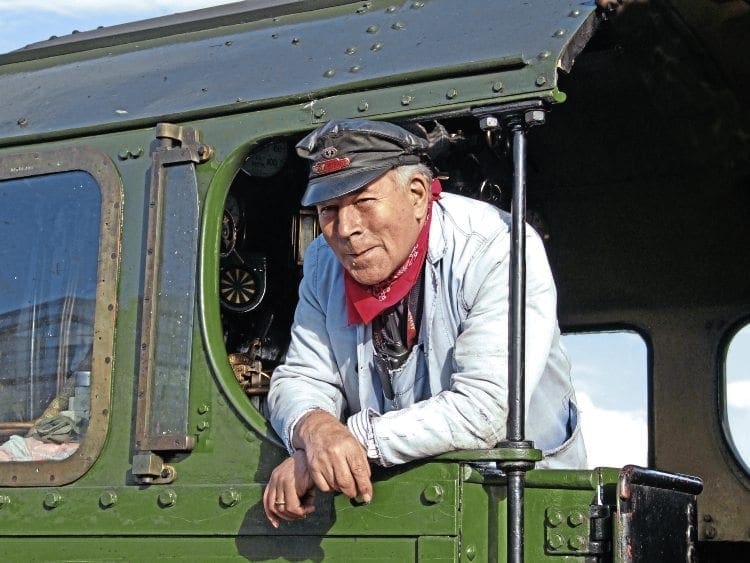
In 2001 he was retired from full-time work with EWS, and was asked to go back as a steam traction inspector on an as-required basis. Before this happened he received a call from Bill Andrew of WCR inviting him to work for the company.
At first he refused saying that Carnforth was too far away but Bill said that they were about to take on some work in the Birmingham area. When Ray said this sounded more feasible a meeting at Tyseley was suggested and Ray realised that Bob Meanley was transferring his train work from EWS to the new WCR and wanted Ray to come on board, which he did in January 2002.
Best years on the railway
WCR was formed in 1998 and was the first private company to be given a train operating licence. Then started what Ray describes as his best years on the railway. He has enjoyed meeting and working with so many nice people, driven many different locomotives and ridden over routes and to places that he would never otherwise have done.
Coincidentally he was born on the same day as Bill Warriner who started at Birkenhead and who he was now going to be working with on steam excursions operated by WCR. What a small world the steam empire really is! He also met the late Brian Dudley Ward while still at EWS when they were made traction inspectors together and that association is what started Ray’s tradition of wearing the trademark red neck scarf.
And so to the WCR years. While Ray worked mainly on steam trips, he remembers a three-day freight turn in March 2012, when he was sent to Burngullow, Cornwall to retrieve some china clay empties to work back to Burton-on-Trent with a class 47 and No. 56301 and on the return run being put into the loop at Hemerdon.
It is impossible in a short article to cover everything he did so I will recall some of the best steam trips, most of which I was on and all of which Ray remembers. I think his top trip must be 1Z48 with Tyseley’s GWR 4-6-0 No. 5043 Earl of Mount Edgcumbe on May 10, 2014, which re-enacted the trip of May 9, 1964, and to be told on arrival at Bristol by the late Mike Notley that he had shaved some three minutes or so off the original record, making him and his fireman –Alastair Meanley – the fastest steam loco crew between Plymouth and Bristol.
Ray also mentioned the ‘Inter-City’ from Birmingham to Marylebone where we were almost brought to a stand at West Ruislip by signals and as the signal cleared a great cheer went up all along the train as our nonstop status had been saved. My own particular memory is that of Bulleid Pacific No. 34067 Tangmere working the ‘Royal Duchy’ on September 7, 2014.
We ran well enough covering the 32.83 miles from Yatton to Taunton in one second under 32 minutes with a maximum of 77½mph just after Brent Knoll and then climbing to Whiteball at a minimum of 38mph followed by a very good storming of Dainton, minimum of 16mph and Rattery 17½mph. I remember thinking though that the engine didn’t seem to be working very hard and it wasn’t until I talked to Ray at Plymouth that I discovered that although the fireman had been providing plenty of steam, they were short of coal and Ray had to eke out what they had to ensure that they made it to Par.
Ray worked part of all nine of the Railway Touring Company’s ‘Great Britain’ trips, bar ‘GB8’ in 2015, which was badly disrupted by the first suspension of WCR and mostly diesel-worked anyway. ‘GB9’ proved to be a different challenge owing to shortage of available steam power so when Ray took over LMS 4-6-0 No. 46100 Royal Scot from Pete Roberts at Exeter on Tuesday, April 26 there was a class 57 diesel on the back to assist over the fierce south Devon banks as the load was 10 for about 390 tons (total gross weight more than 500 tons), well over the load limit for a class 7 locomotive.
Ray had other ideas though and took Royal Scot over Dainton with no help from the diesel on the rear, working No. 46100 in about three quarters regulator, and cut-off progressively increased to 40 and 45%. This he told me was his normal style of driving, listening to the engine, watching the speed and gradually increasing the cut-off bit by bit to the maximum he thought was needed. He also told me that you couldn’t really do this on Tangmere as Bulleid’s steam reverser didn’t lend itself to small adjustments and was just as likely to jump from 20% to full forward gear with disastrous consequences for the fire. (I can testify to this from my footplate rides on the Southern in the days of steam).
To get to 100mph
Ray was once firing LMS Pacific No. 46251 City of Nottingham when the inspector told his driver (Cyril Duckhouse) that this was to be a special run and he wanted him to work the engine in full regulator and 45% cut-off to get to 100mph. This isn’t normally the best way to achieve that result and sure enough they failed to reach the ton that day.
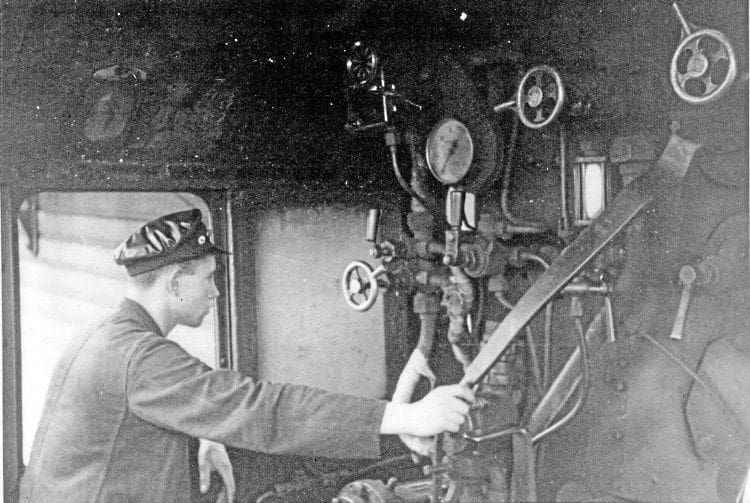
Fortunately for Ray’s health the driver only worked the engine in first valve and 45%, reaching 87mph down the bank to Crewe. Ray is right, of course, and it is no way to handle a locomotive anyway except for short periods climbing steep gradients. Some of the 100mph runs with Merchant Navy Pacifics at the end of steam were produced with the engines being worked at about three quarters regulator and 20-22% cut-off.
On ‘GB9’ Ray worked No. 46100 down from Exeter to Plymouth, then took Royal Scot light engine on to Penzance after turning at Laira. ‘Black Five’ No. 44871 should have been the second engine but this had failed a few days before with a broken radius rod, which is why a class 57 diesel was provided. As already stated Ray refused help from this over Dainton but took some assistance from Tigley church to the top of the 1-in-90/65 up the long climb of Rattery bank. Although Dainton is steeper at 1-in-36 it is short and sharp but Rattery is much longer and Ray didn’t want to risk stalling and blocking the main line.
He said that often you would get checked at signal E100, which is the last signal controlled by Exeter ‘box, just west of Totnes. He recalled one occasion when they were checked down to walking pace and opened up as the signal cleared only to slip to a stand about three train lengths beyond the signal on the 1-in-66. Eventually he managed to restart the train but not until after a big struggle with the engine, BR Standard Pacific No. 70013 Oliver Cromwell. Normally he would contact the signalmen at Exeter to ask them to ensure that he had a clear road and often had to run easily down from Dainton to Totnes to ensure that the train in front had cleared.
The next day on ‘GB9’, Wednesday, April 27, Ray took No. 46100 all the way from Penzance to Bristol where I met him when the train arrived on time at 5.51pm after a good run. He was, of course, wearing his red scarf, this one given to him by the train timing guru, Mike Notley, sadly no longer with us and much missed. The accompanying images clearly show the red scarf with one also being worn by his fireman Chris Birmingham.
Favourite engine
Ray had taken assistance from the Class 57 up the long and steep Hemerdon but once again not over Dainton. The next day, Thursday, April 28 was to be Ray’s last day on the main line and as a result of some very hard work by all concerned No. 44871 had been repaired and so he drove this on the next leg from Bristol to Crewe. Unfortunately the coal supplied was very poor and steaming was a problem throughout so it was just as well that the diesel stayed on the rear of the train to help.
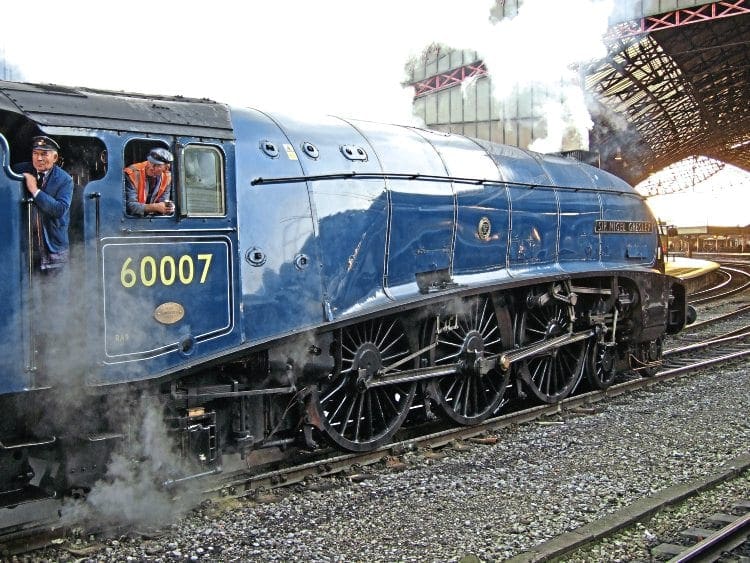
I asked him what he considered to be his favourite engine of all those he has driven and he thought for a moment and then said “fifty forty-three’’. Yes No. 5043 Earl of Mount Edgcumbe, of course, which is no surprise really. I then suggested to him that Castles needed to have full or nearly full pressure to produce the best results and he agreed, also adding that they were best worked in second valve with full boiler pressure and cut-off adjusted to suit the conditions and to keep or regain time.
Sadly he has decided that now is the time to call it a day for a number of reasons. Ray didn’t have to retire and many people including those at WCR have tried to persuade him to stay on. He told me the main reason was the long hours he had to travel to get to the jobs, not always in easy circumstances. Maybe if it hadn’t been for the latest WCR suspension he would have stayed on but the extra long break he had between Christmas and the April restart appears to have settled it. His wife told me that he is a keen handyman about the house, and that they both enjoy spending many happy hours in the garden, and visiting places of interest.
Ray is a member and shareholder of the Severn Valley Railway. I asked him if he would like to drive on the SVR but says he’s probably too old and it’s time to hang up his greasetop anyway. I suggested maybe staying on with WCR as a traction inspector now that this is a requirement but I don’t think that is going to happen. I think it now seems inevitable that we are going to lose one of the best-known, highly regarded and thoughtful enginemen from the scene and no more will I be able to walk to the front of the train looking for that trademark red scarf, knowing that whatever the engine or its condition a good run would be guaranteed.
I am very grateful to both Ray and his wife Nickey for giving up their time to see me and for checking and amending my script to ensure that it is as accurate as possible. Any errors, however, are entirely down to me.
Read more News and Features in Issue 232 of HR – on sale now!
Archive enquiries to: Jane Skayman on 01507 529423 – [email protected]
Advert
 Enjoy more Heritage Railway reading in the four-weekly magazine. Click here to subscribe.
Enjoy more Heritage Railway reading in the four-weekly magazine. Click here to subscribe.

